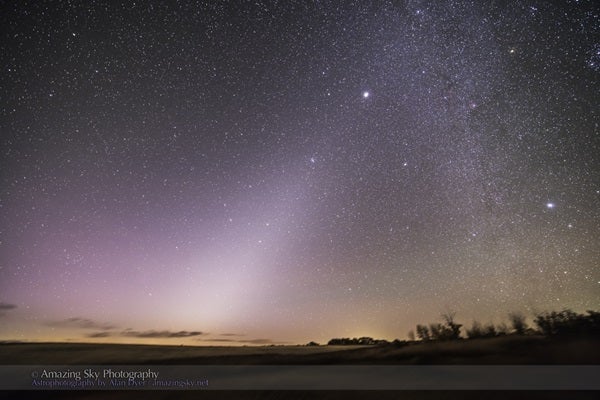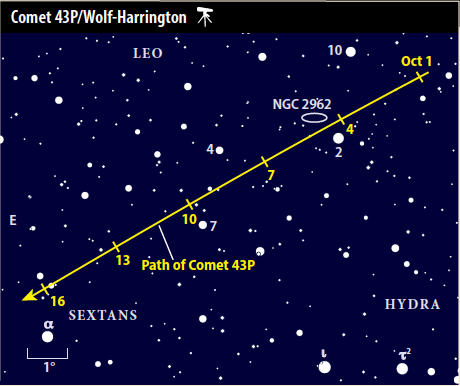Mercury is in the midst of its finest morning apparition of 2016. Although the planet reached its greatest elongation from the Sun on September 28, it continues to brighten in early October and remains well-placed. Tomorrow morning, for example, the inner world shines at magnitude –0.8 and lies 8° above the eastern horizon 45 minutes before sunrise. You should be able to see it with your naked eye, though binoculars can help you to find it initially in the twilight glow. When viewed through a telescope, Mercury’s 7″-diameter disk appears slightly more than half-lit.
New Moon occurs at 8:11 p.m. EDT. At its New phase, the Moon crosses the sky with the Sun and so remains hidden in our star’s glare.
Saturday, October 1
The Moon’s absence from the morning sky these next two weeks provides observers with an excellent opportunity to view the zodiacal light. From the Northern Hemisphere, the time around the autumnal equinox (which occurred last week) is the best for viewing the elusive glow before sunrise. It appears slightly fainter than the Milky Way, so you’ll need a clear moonless sky and an observing site located far from the city. Look for a cone-shaped glow that points nearly straight up from the eastern horizon shortly before morning twilight begins (around 5:30 a.m. local daylight time at mid-northern latitudes). The Moon remains out of the morning sky until October 15, when the waxing gibbous returns and overwhelms the much fainter zodiacal light.
Sunday, October 2
Tonight marks the unofficial start of the annual Orionid meteor shower. Although the Orionids won’t peak for nearly three weeks (on the morning of October 21), you should start to see a few shower members in the Moon-free early morning hours. These meteors appear to radiate from the northern part of the constellation Orion the Hunter.
A slender crescent Moon appears 5° above Venus in this evening’s sky. The pairing of the night sky’s two brightest objects set against the vivid colors of twilight will make a stunning scene.
Tuesday, October 4
Comet 43P/Wolf-Harrington currently glows at 12th magnitude among the background stars near Leo’s border with Hydra and Sextans. This region climbs some 25° above the eastern horizon by the time morning twilight begins. You’ll need an 8-inch or larger telescope to spot the comet, which should appear as a small, slightly out-of-round fuzzball. Compare its appearance to the similarly bright spiral galaxy NGC 2962, which lies just 0.7° east of 43P this morning. (Tomorrow morning, the comet passes 0.4° south of the galaxy.)
The Moon reaches apogee, the farthest point in its orbit around Earth, at 7:03 a.m. EDT. It then lies 252,336 miles (406,096 kilometers) from Earth’s center.
Wednesday, October 5
The waxing crescent Moon appears about 5° to the right of Saturn this evening. The two stand 20° high in the southwest an hour after sunset and remain on view past 9 p.m. local daylight time. Although the scene looks best with the naked eye or binoculars, magnitude 0.5 Saturn is worth viewing through a telescope any time this week. The ringed planet shows a 16″-diameter disk surrounded by a dramatic ring system that spans 36″ and tilts 26° to our line of sight.
Ruddy Mars continues to put on a nice show in October’s evening sky. The Red Planet shines brightly at magnitude 0.1 and appears about 20° high in the south-southwest once twilight fades to darkness. Target Mars through a telescope this evening and you’ll see a 9″-diameter disk with a few subtle dark markings. But with a low-power eyepiece, you’ll also see the 7th-magnitude globular star cluster M28 just 0.8° to the north. As the planet treks eastward relative to the backdrop of Sagittarius this week, it will have several more close encounters with deep-sky objects.
Thursday, October 6
Look high in the east after darkness falls this week and you should see autumn’s most conspicuous star group. The Great Square of Pegasus stands out in the evening sky at this time of year, though it appears balanced on one corner and looks more diamond-shaped than square. These four almost equally bright stars form the body of Pegasus the Winged Horse. The fainter stars that form the rest of this constellation’s shape trail off to the square’s west.
Mars’ eastward motion carries it 0.2° south of the 3rd-magnitude red giant star Lambda (l) Sagittarii this evening.
The waxing crescent Moon’s eastward march carries it nearly 10° to the upper right of Mars this evening. Meanwhile, the Red Planet’s slower motion brings it to a spectacularly close conjunction with the 9th-magnitude globular star cluster NGC 6638. Mars skims just 4′ south of the cluster at closest approach.
Saturday, October 8
The First Quarter Moon appears high in the south as darkness falls and remains on view until nearly midnight local daylight time. Our satellite officially reaches its First Quarter phase at 12:33 a.m. EDT tomorrow morning (9:33 p.m. PDT today), but it looks half-lit all evening. The Moon lies among the background stars of northern Sagittarius, above that constellation’s Teapot asterism.
Although Uranus reaches opposition just one week from today, it already has become a tempting evening target. The ice giant world rises during twilight and climbs nearly 50° above the southeastern horizon by 11 p.m. local daylight time. The magnitude 5.7 planet lies in Pisces, 2.5° northwest of magnitude 4.8 Mu (m) Piscium. Despite being bright enough to see with the naked eye under a dark sky, Uranus shows up more easily through binoculars. A telescope reveals the planet’s blue-green disk, which spans 3.7″.
Sunday, October 9
Mars concludes its exceptional parade past Sagittarius’ globular clusters this evening, when it passes 1.6° south of 5th-magnitude M22. The best views should come through binoculars and rich-field telescopes.
The night sky’s most conspicuous harbinger of winter now rises in the east around midnight local daylight time. The constellation Orion the Hunter appears on its side as it rises, with ruddy Betelgeuse to the left of the three-star belt and blue-white Rigel to the belt’s right. As Orion climbs higher before dawn, the figure rotates so that Betelgeuse lies at the upper left and Rigel at the lower right of the constellation pattern.












